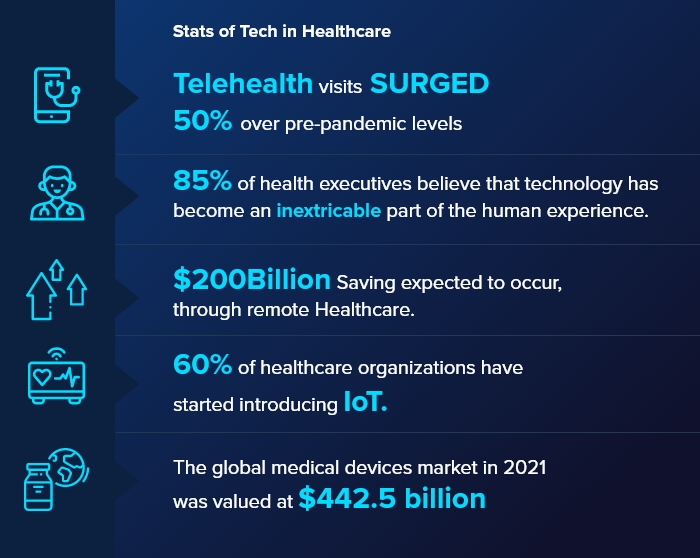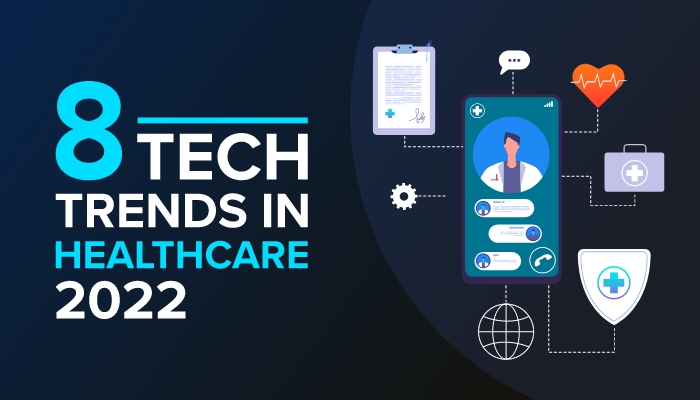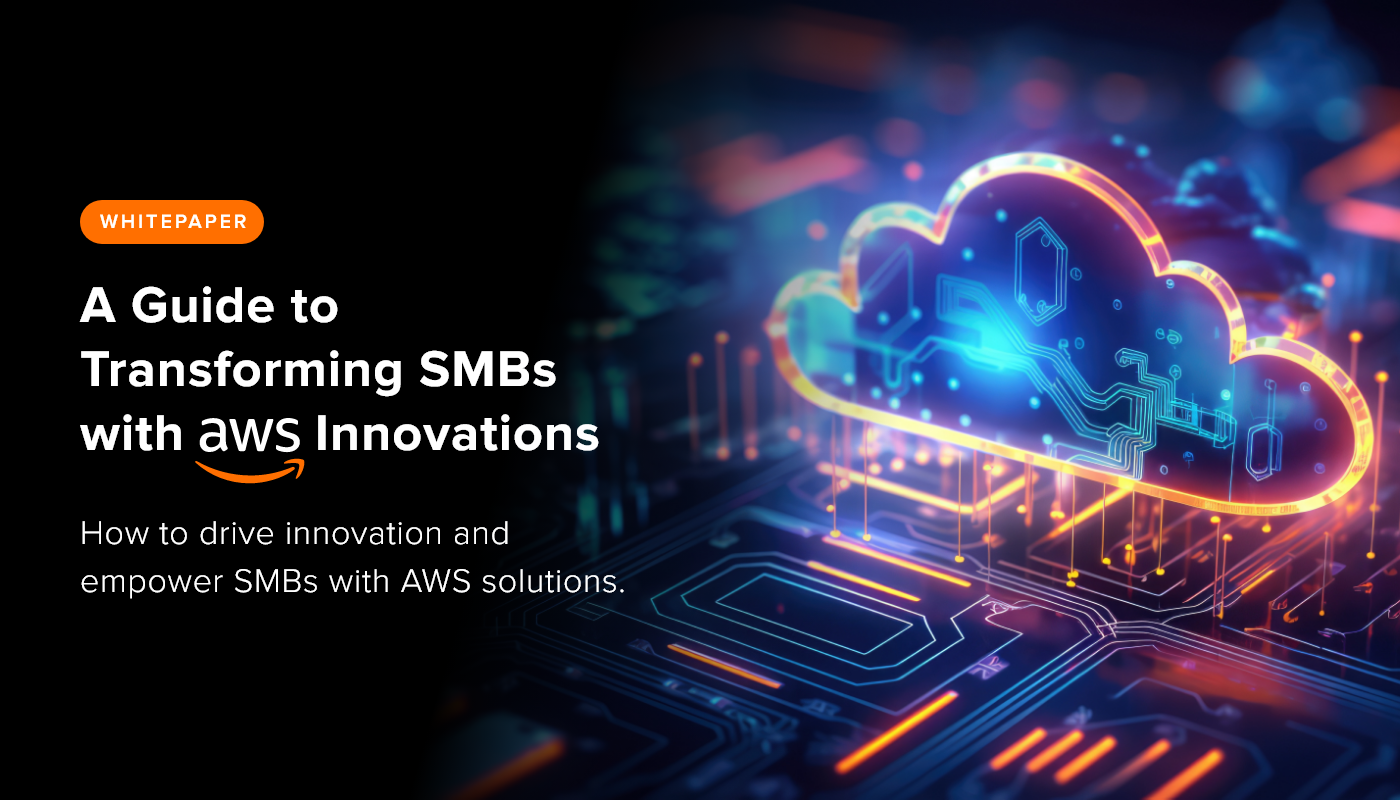Hospitals, health systems, and patients increasingly depended on digital health technologies for care delivery during the pandemic, health IT adoption soared in 2021, paving the way for continuous growth and innovation in 2022.
Tech-infused tools are being integrated into every step of our healthcare experience to counteract two key trouble spots: quality and efficiency.
2022 is expected to strengthen the healthcare industry through breakthrough discoveries and innovations. The US healthcare market is growing at a rapid pace and is expected to be worth USD 6 trillion by 2026.
Stats of Tech in HealthCare

8 Top Tech Trends in Healthcare:
Patient-Generated Health Data(PGHD)

Health Data such as:
- Treatment history, with all the health details;
- symptoms of the disease
- data on the healing process
- personal biometric data
- habits, lifestyle, etc.
A record of these data can be maintained and the use and sharing of PGHD supplement existing clinical data, filling in gaps in information and providing a more comprehensive picture of ongoing patient health.
Real-Time Health Tracking
![]()
Tracking the determinants of pressure, pulse rate, sleep period, distance covered and the number of steps is not enough anymore for a tracking application. To meet the growing demand for personal health data, modern personal health care apps and devices should be able to :
- To track the information with a minimal measure of inaccuracy.
- To make it possible to see this data in a readable form.
- To save the health data and be able to do a statistical analysis of the user’s indicators.
- To compare determinants with the standards.
- To offer advice for improving the health indexes.
Telemedicine

Telehealth has become a mainstream practice, with widespread adoption across the Patient-Care continuum. Advanced clinics are already doing a lot of consulting with their patients. The Telemedicine market is expected to reach an astonishing $459.8 billion by 2030 with a CAGR of 30%.
- China has developed a national telehealth program in 70% of public hospitals
- The US is also among the top telemedicine pioneers. The US government plans to create more off-site options in the years to come to reduce the maintenance costs of medical facilities and hence the cost of healthcare services.
- Other advanced countries are also turning their heads towards telehealth and developing their projects, keeping in mind local needs and peculiarities.
- In 2021, 72% of US patients used telemedicine at least once.
Cloud Computing

Cloud computing and its adoption in healthcare are now in full swing and will witness surging growth in the future. According to MarketsandMarkets, the global healthcare cloud computing market is projected to grow by 17.2% by 2024, and the market is expected to reach $51.9 billion by 2024.
It is the solution to many challenges in service delivery, such as
- Record management,
- Remote care, and
- Reaching low-income patients
Providers are using the cloud to manage PHR(Patient Health Records) and EMRs more efficiently, making real-time data available to healthcare professionals.
HIMSS (Healthcare Information and Management Systems Society) survey claims that “Cloud solutions are an extension of a healthcare organization’s communications infrastructure. Connectivity should easily ‘scale up,’ as more applications are moved to the cloud.”
Internet of Medical Things (IoMT)

The global Internet of Medical Things (IoMT) market is expected to grow to $172.4 billion by 2030.
Wearable devices and trackers are a huge part of the development of information technology in healthcare. The key benefit of using a medical monitor is that it provides real-time and detailed data on the patients’ health states.
IoMT enables patients to be more aware of their health and their overall well-being. Trackers allow people to view real-time data on their daily behavior.
AI in HealthTech

Artificial Intelligence in Healthcare is utilized to analyze the treatment techniques of different diseases and prevent them. AI is used in various areas of healthcare such as diagnosis processes, drug research sector, medicine, patient monitoring care center, etc. AI helps to gather past data through electronic health records for disease prevention and diagnosis.
AI algorithms can swiftly process computed tomography scans of thousands of patients, detecting pneumonia patterns caused by Viruses and reporting these to clinicians.
AI is used to make diagnoses more accurately based on information from patients’ electronic health records(EHR).
In January 2020, a team of British and Japanese scientists patented the first drug molecule created by AI. The medication has been accepted for human testing and will be used to treat obsessive-compulsive disorder.
Big Data and EHR(Electronic health record)

There is a large enough database to tally up stats of medical appointment booking and estimate how many actual doctors are working on a weekday, as well as the most frequent health problems of customers. This can help the institution to operate more profitably.
Big Data Analytics and Electronic Health Records (EHRs) are an important trend in current healthcare, and they are vitally important for ensuring accurate and efficient care. This service opens the door for patients and their doctors to have on-demand access to data about their health, such as cardiac waveforms, chronic diseases, diagnostics, and past prescriptions.
AR in Healthcare

AR and AI can help healthcare providers and patients by providing more efficient and helpful services. It is possible to view the location of a human’s digestive organs, blood vessels, and respiratory system, as well as their skeleton, using a camera. In medical practice, augmented reality helps, for example, by giving an injection, which statistically causes nurses to lose a vein 4 times out of 10.
Medical applications that support augmented reality will make major operations much easier in 2022, as the technology is indisputably helpful.
Conclusion
The uses of healthcare technology are seemingly endless. To improve efficiency throughout the industry and make the patient experience as painless as possible, healthcare tech is being implemented in everything from administrative processes, to a more complete and accurate diagnosis.
The future of healthcare is working together with health technology, and healthcare workers have to accept emerging healthcare tech to stay relevant in the years to come.
Talk to us at gleecus.com/contact-us




